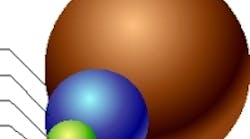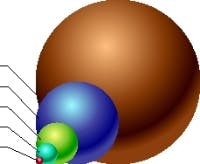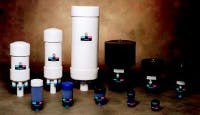Relative sizes of some common items put the micron designation into perspective.
The last time you suffered from the flu, did you think about the size of the virus that was shutting you down? Relate that to a hydraulic system, and you'll find that at least 70% of system failures are caused by something so small that it cannot be seen. In fact, a particle as small as 5 to 10 µm in a critical component can easily shut down a hydraulic system.
Now think back to the last time your plant had a system shut down and ask three questions:
- how expensive were the parts needed to make the repair?
- how much money was lost in production and revenue?
- how expensive was the filter that could have been installed during scheduled maintenance?
Proper filtration can be a cost-effective insurance policy against system failure and the resultant downtime, repair expense, and lost revenue. A $20 filter element can prevent the failure of a system component that can end up costing $2000 when the cost of replacement and downtime are considered. In addition, properly sized and placed filters can help prevent heat build-up and leakage and their associated costs.
Filtration basics
The most common rating factors for filters are dirt-holding capacity, beta ratio, and particle size. Dirtholding capacity (given in grams) is a measure of the amount of contaminant a filter can trap. It is a gross rating based on the weight of particulate a filter can capture.
| Beta ratio | Efficiency |
| 1 | 0% |
| 2 | 50.00% |
| 5 | 80.00% |
| 10 | 90.00% |
| 20 | 95.00% |
| 75 | 98.70% |
| 100 | 99.00% |
| 200 | 99.50% |
| 1000 | 99.90% |
| 5000 | 99.98% |
Beta ratio indicates how many particles of a particular size can pass through an element. For example, a filter with a beta ratio of ß100 = 2 retains 1/2 of all particles 100 µm and larger in size. Filters with a higher beta ratio retain more particles and have higher efficiency. Most manufacturers recommend the proper filtration for each component. The system's filtration requirements should be based on the component with the finest filtration needs.
Particle size is measured in µm, where 1 µm equals one millionth of a meter. To put that into perspective, a human hair is about 80 µm, and particles smaller than 35 µm are not visible to the naked eye.
Sizing filters
It is generally accepted that at least 70% of all fluid power system failures are due to contamination. Contamination can be in the form of particles or water, and can easily be controlled with a few wellplaced filters and regular preventive maintenance. A high-quality filter with the correct particle size rating can extend the life of the entire system and keep a plant in good operating condition.
When selecting filters, first check the component manufacturer's literature for filtration requirements of pumps, valves, and actuators. When in doubt, use a filter rated for a smaller particle size. A typical hydraulic system requires the filtration of 5 to 10-µm particles. Systems containing servovalves or proportional valves require 1 to 3-µm filtration.
Finally, do not be alarmed when newly installed filters have to be changed frequently. It usually just means a lot of contamination is being removed initially. Once the system has been in operation, it should reach equilibrium and require less frequent changes. Of course, if this situation continues for a long time, the system should be checked to find and correct the source of the contamination.
Filter placement
The number of filters required by a system depends on system complexity. For example, a basic system consisting of a gear pump, manual valve, and cylinder probably doesn't need much more than a return-line filter. These types of system components typically have fairly wide internal tolerances, so they are not affected by a small amount of contamination. Also, using additional filters may cost more than the components being protected. The filter is placed in the return line to minimize pressure drop in the system and to remove contaminants and wear particles before they enter the reservoir.
More sophisticated systems using critical, close-tolerance components — such as piston pumps and servovalves — need more than one filter. Typically, a filter is placed upstream of all critical components. The cost of the extra filtration is minimal compared to the cost of replacing these precision components.
As an added measure of protection, precision systems often include a circuit for cooling and filtration — these are referred to as off-line or kidney-loop systems. These systems have their own small pump to draw fluid out of the reservoir, clean it, and return it to the main system. They are easy to install and continuously circulate fluid to clean it. The continuous flow through a fine filter improves system cleanliness and extends the life of other system filters. Because off-line systems use lower pressure filters, they are generally very cost-effective. In fact, they need not be permanently installed on a system. Rather, they can be installed on a portable cart, equipped with quick-acting couplings, and moved from one machine to another.
Filter maintenance
A final important consideration is filter maintenance and replacement. Generally, visual inspection of a filter element does not provide any information on how much particulate it has captured or how much useful life remains. Some plants solve this problem by changing filters on a regular maintenance schedule. However, this approach may waste unused element life. On the other hand, too little attention could result in a plugged element and contamination of the system.
Many filters have an electrical indicator that signals when the element is getting plugged. The key is monitoring the indicator regularly and taking corrective action.
Tom Nash is the product manager – fluid power hydraulics at Applied Industrial Technologies. Contact him at [email protected].
Sources of contamination
New oil | Airborne particles |
| New or make-up oil should always be filtered before adding it to the reservoir. Although oil labeled as ready for use may be chemically sound, it typically has not been filtered to remove particulates. New oil also can be contaminated by airborne particles during storage. The use of a quality filter cart to transfer the fluid through filters is recommended when adding or transferring any hydraulic fluid. | As a hydraulic system operates, fluid levels in the reservoir fluctuate as cylinders stroke and fluid temperature changes. Typically, a breather with a coarse filter is installed on the reservoir to allow this fluctuation without creating backpressure in the system. To keep systems clean, the breather should be changed at the same time as the other filters in the system. |
Water
Generated particles
External particles
Let your system breathe easier!
Many systems have breather caps that allow grit, oxides, and sludge to enter the reservoir. By replacing the standard breather cap with a Beach Breather, contaminants are removed at filtration which exceeds most industry standards. The Beach Breather works in three stages:
- air passes through a low-density foam filter and a knitted polyester filter
- water vapor is removed by desiccant crystals, and
- a second polyester and foam filter remove particles that may have been introduced by the desiccant
The desiccant crystals are chemically inert, non-toxic, and non-corrosive. Color change in the filter lets users know when it is time to replace the breather, which can be disposed of as solid waste and is non-hazardous to the environment.
Beach Breathers are available in three different models — small disposable breathers for general use, tank breathers made of all-weather PVC for larger systems such as refineries and food processing plants, and steel breathers for corrosive and extremely hot environments. For more information, email [email protected] or visit www.beachfilters.com.



